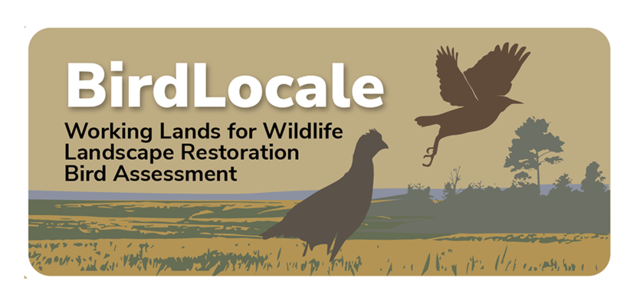-
South Atlantic LCC
-
by
Web Editor
—
published
Mar 02, 2012
—
last modified
Aug 29, 2013 09:07 AM
—
filed under:
Website,
Climate Change,
NE-SE Regional LCC Network
The South Atlantic Landscape Conservation Cooperative (SALCC) is part of a national network of Landscape Conservation Cooperatives (LCCs). The partnership will consider landscape-scale stressors, including climate change, habitat fragmentation, invasive species, and water scarcity as it attempts to provide a vision for a landscape capable of sustaining healthy populations of fish, wildlife, plants and cultural resources. The SALCC crosses six states, from southern Virginia to northern Florida.
Located in
Cooperative
/
The Network
/
Neighboring LCCs
-
South Atlantic LCC Web Forum
-
by
Matthew Cimitile
—
published
Apr 15, 2014
—
last modified
Apr 15, 2014 09:37 AM
—
filed under:
Climate Change,
Events,
Climate Adaptation,
Forests
Can forests take the heat? Managing pests and ecosystem services in a warming climate
Located in
News & Events
/
Events
-
 South-Central Interior Small Stream and Riparian Habitat
South-Central Interior Small Stream and Riparian Habitat
-
by
Lesley Sneddon
—
published
Dec 01, 2015
—
last modified
Dec 17, 2015 11:55 AM
—
filed under:
Climate Impacts,
Climate Adaptation,
Habitat,
Climate Change,
NGO,
Ecosystems
This habitat was assessed in both the Cumberland - Southern Appalachian subregion and the Interior Low Plateau subregion. Results are in the first two tabs of the spreadsheet. A description of the habitat, and a list of associated species, is included in the description tab. The remaining tabs describe the individual factors and their definitions. These results are in the review stage. Please send comments to lesley_sneddon@natureserve.org.
Located in
Projects
/
…
/
Phase II: Vulnerability Assessments
/
Habitat Vulnerability Assessments
-
Southeast Climate Adaptation Science Center-Science Seminar – Southeast Regional Invasive Species and Climate Change
-
by
Web Editor
—
published
Dec 06, 2022
—
filed under:
SECASC,
Climate Change,
Events,
Southeast Climate Adaptation Science Center,
Invasive Species
Join us for our Fall/Winter virtual science seminar series highlighting SE CASC funded projects supporting resource management actions across the Southeast. Each month a SE CASC researcher will provide an overview of their work and the management implications of their research findings.
Located in
News & Events
/
Events
/
Upload New Events
-
Southeastarn CSC Revamps Website
-
by
Southeastarn Climate Science Center
—
published
Feb 01, 2013
—
last modified
Feb 01, 2013 11:45 AM
—
filed under:
Website,
Climate Change,
Federal,
News
The Department of the Interior Southeastern Climate Science Center has recently revamped its website to include sections on funded projects, partner LCCs, partner resources, and much more.
Located in
News & Events
-
Southern Appalachian Forest Water Yield Down since 1970s
-
by
Caldwell, Peter V.; Miniat, Chelcy F.; Elliott, Katherine J.; Swank, Wayne. T.; Brantley, Steven T.; Laseter, Stephanie H.
—
published
Jun 06, 2016
—
filed under:
Climate Change,
Forests,
Water supply,
News
Climate change and forest disturbances are threatening the ability of forested mountain watersheds to provide the clean, reliable, and abundant fresh water necessary to support aquatic ecosystems and a growing human population.
Located in
News & Events
-
 Species and Habitat Vulnerability Assessments of Appalachian Species and Habitats
Species and Habitat Vulnerability Assessments of Appalachian Species and Habitats
-
by
Matthew Cimitile
—
published
Dec 03, 2012
—
last modified
Apr 28, 2017 08:15 AM
—
filed under:
Climate Change,
Land Use,
AppLCC Funded,
Our Work,
Research,
Science and Research Products
Future climate change adaptation and mitigation strategies will be dependent on the best available projections of how the regional climate will change and the impacts those changes will have on the region’s natural and cultural resources. Understanding the vulnerability of various species and habitats to climate change within the Appalachian LCC is of critical importance for making effective conservation decisions. The AppLCC funded a Climate Change Vulnerability Assessment research project that addresses several factors: 1) how the Cooperative should acquire information about the climate vulnerability of Appalachian species and habitats to develop vulnerability assessments for a suite of key species and habitats to share with partners; 2) compilation of known vulnerability assessments of species and habitats, and 3) new climate change vulnerability assessments of selected species and habitats in the AppLCC region.
Located in
Research
-
Spring 2012 Earliest on Record
-
by
U.S. Geological Survey
—
published
May 28, 2013
—
filed under:
Climate Change,
News
March 2012 set records for warm temperatures that promoted early leafing and flowering across large areas of the United States.
Located in
News & Events
-
State Agencies and Climate Change Planning
-
by
Jean Brennan
—
published
Dec 21, 2012
—
last modified
Aug 27, 2013 09:29 AM
—
filed under:
Climate Change,
State
State Wildlife Action Plans prepared by natural resource agencies describe monitoring species and their habitats, monitoring the effectiveness of the conservation actions proposed, and adapting these conservation actions to respond appropriately to new information or changing conditions, including climate change. Other agencies at the state and federal level have also identified a need to plan strategically for climate change. The following states had published climate change plans or reports at the time of publication of the Appalachian Development and Operations Plan.
Located in
Cooperative
/
Our Plan
/
Section 1: Biodiversity and Conservation Challenges Across the Appalachian Region
-
 Structural and Functional Loss in Restored Wetland Ecosystems
Structural and Functional Loss in Restored Wetland Ecosystems
-
by
Web Editor
—
published
Mar 24, 2012
—
filed under:
Report,
Climate Change
Wetlands, which include tropical mangroves and boreal
peatlands, are among the most valuable ecosystems in the
world because they provide critical ecosystem goods and
services, such as carbon storage, biodiversity conservation,
fish production, water purification, and erosion control. As
global change accelerates the loss of wetlands, attempts
are increasing to restore this fragile habitat and its
associated functioning. There has been no global evaluation,
however, of how effective such restoration efforts
have been. Here, we present a meta-analysis of the
biological structure (driven mostly by plant communities)
and biogeochemical functioning (driven primarily by the
storage of carbon in wetland soils) of 621 wetland sites.
Located in
Resources
/
General Resources Holdings


